The reticulon and DP1/Yop1p proteins form immobile oligomers in the tubular endoplasmic reticulum
- PMID: 18442980
- PMCID: PMC2441541
- DOI: 10.1074/jbc.M800986200
The reticulon and DP1/Yop1p proteins form immobile oligomers in the tubular endoplasmic reticulum
Abstract
We recently identified a class of membrane proteins, the reticulons and DP1/Yop1p, which shape the tubular endoplasmic reticulum (ER) in yeast and mammalian cells. These proteins are highly enriched in the tubular portions of the ER and virtually excluded from other regions. To understand how they promote tubule formation, we characterized their behavior in cellular membranes and addressed how their localization in the ER is determined. Using fluorescence recovery after photobleaching, we found that yeast Rtn1p and Yop1p are less mobile in the membrane than normal ER proteins. Sucrose gradient centrifugation and cross-linking analyses show that they form oligomers. Mutants of yeast Rtn1p, which no longer localize exclusively to the tubular ER or are even totally inactive in inducing ER tubules, are more mobile and oligomerize less extensively. The mammalian reticulons and DP1 are also relatively immobile and can form oligomers. The conserved reticulon homology domain that includes the two membrane-embedded segments is sufficient for the localization of the reticulons to the tubular ER, as well as for their diffusional immobility and oligomerization. Finally, ATP depletion in both yeast and mammalian cells further decreases the mobilities of the reticulons and DP1. We propose that oligomerization of the reticulons and DP1/Yop1p is important for both their localization to the tubular domains of the ER and for their ability to form tubules.
Figures
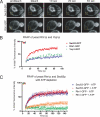
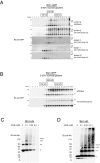
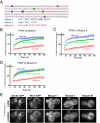
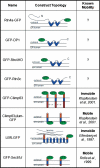
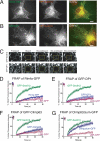
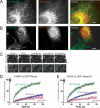
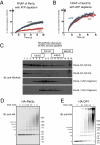

Similar articles
-
A class of membrane proteins shaping the tubular endoplasmic reticulum.Cell. 2006 Feb 10;124(3):573-86. doi: 10.1016/j.cell.2005.11.047. Cell. 2006. PMID: 16469703
-
ER network formation requires a balance of the dynamin-like GTPase Sey1p and the Lunapark family member Lnp1p.Nat Cell Biol. 2012 Jun 24;14(7):707-16. doi: 10.1038/ncb2523. Nat Cell Biol. 2012. PMID: 22729086 Free PMC article.
-
Membrane proteins of the endoplasmic reticulum induce high-curvature tubules.Science. 2008 Feb 29;319(5867):1247-50. doi: 10.1126/science.1153634. Science. 2008. PMID: 18309084
-
ER structure and function.Curr Opin Cell Biol. 2013 Aug;25(4):428-33. doi: 10.1016/j.ceb.2013.02.006. Epub 2013 Mar 13. Curr Opin Cell Biol. 2013. PMID: 23478217 Free PMC article. Review.
-
Molecular basis for sculpting the endoplasmic reticulum membrane.Int J Biochem Cell Biol. 2012 Sep;44(9):1436-43. doi: 10.1016/j.biocel.2012.05.013. Epub 2012 May 26. Int J Biochem Cell Biol. 2012. PMID: 22640864 Review.
Cited by
-
Endoplasmic Reticulum: The Favorite Intracellular Niche for Viral Replication and Assembly.Viruses. 2016 Jun 7;8(6):160. doi: 10.3390/v8060160. Viruses. 2016. PMID: 27338443 Free PMC article. Review.
-
Exploring the eukaryotic Yip and REEP/Yop superfamily of membrane-shaping adapter proteins (MSAPs): A cacophony or harmony of structure and function?Front Mol Biosci. 2022 Aug 19;9:912848. doi: 10.3389/fmolb.2022.912848. eCollection 2022. Front Mol Biosci. 2022. PMID: 36060263 Free PMC article. Review.
-
Membrane-mediated aggregation of curvature-inducing nematogens and membrane tubulation.Biophys J. 2013 Mar 5;104(5):1018-28. doi: 10.1016/j.bpj.2012.12.045. Biophys J. 2013. PMID: 23473484 Free PMC article.
-
ER-phagy drives age-onset remodeling of endoplasmic reticulum structure-function and lifespan.bioRxiv [Preprint]. 2024 Aug 8:2024.08.07.607085. doi: 10.1101/2024.08.07.607085. bioRxiv. 2024. PMID: 39149405 Free PMC article. Preprint.
-
Fam134c and Fam134b shape axonal endoplasmic reticulum architecture in vivo.EMBO Rep. 2024 Aug;25(8):3651-3677. doi: 10.1038/s44319-024-00213-7. Epub 2024 Jul 22. EMBO Rep. 2024. PMID: 39039299 Free PMC article.
References
-
- Staehelin, L. A. (1997) Plant J. 11 1151-1165 - PubMed
-
- Baumann, O., and Walz, B. (2001) Int. Rev. Cytol. 205 149-214 - PubMed
-
- Estrada de Martin, P., Novick, P., and Ferro-Novick, S. (2005) Biochem. Cell Biol. 83 752-761 - PubMed
-
- Shibata, Y., Voeltz, G. K., and Rapoport, T. A. (2006) Cell 126 435-439 - PubMed
Publication types
MeSH terms
Substances
Grants and funding
LinkOut - more resources
Full Text Sources
Other Literature Sources
Molecular Biology Databases
Research Materials

